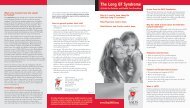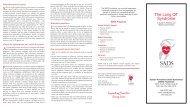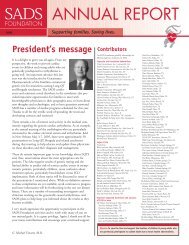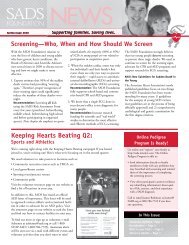Timothy Syndrome - SADS Foundation
Timothy Syndrome - SADS Foundation
Timothy Syndrome - SADS Foundation
You also want an ePaper? Increase the reach of your titles
YUMPU automatically turns print PDFs into web optimized ePapers that Google loves.
<strong>Timothy</strong> <strong>Syndrome</strong><br />
A Guide for Patients and Health Care Providers<br />
by Katherine <strong>Timothy</strong>, September 28, 2005.<br />
A note from the <strong>SADS</strong> <strong>Foundation</strong>.<br />
We provide this information with the hope that informing physicians, other health care providers, and the public will encourage<br />
early and correct diagnosis and proper therapy, resulting in the reduction and ultimately elimination of cardiac arrest and sudden<br />
death from <strong>Timothy</strong> <strong>Syndrome</strong> and other inherited arrhythmias.<br />
What is <strong>Timothy</strong> <strong>Syndrome</strong>?<br />
<strong>Timothy</strong> <strong>Syndrome</strong> (TS) is a rare and serious genetic disorder<br />
characterized by a spectrum of complicated health concerns<br />
which include:<br />
♥ abnormally prolonged repolarization time of the heart<br />
(the process of returning heart cells to a resting state in<br />
preparation for the next heart beat), as measured by a rate<br />
corrected QT interval of >480 to 700 ms, predisposing a<br />
child to serious cardiac events including cardiac arrest<br />
and sudden death,<br />
♥ syndactyly (webbing between or apparent fusing) of<br />
fingers or toes<br />
♥ congenital heart defects (structural heart anomalies<br />
present at birth),<br />
♥ facial anomalies,<br />
♥ weakened immune system,<br />
♥ developmental delays and autism.<br />
The genetic discovery of TS was made in 2004 by researches at<br />
Children’s Hospital Boston, Howard Hughes Medical Institute<br />
and University of Pavia, Italy.<br />
How is <strong>Timothy</strong> syndrome recognized and diagnosed?<br />
<strong>Timothy</strong> syndrome can often be suspected in a child before<br />
birth when the fetal heart rate is noted to be bradycardic<br />
(abnormally slow) or the fetus is found to be in distress. At<br />
birth or with the first feeding the neonate can suddenly develop<br />
hypoxia (diminished availability of oxygen) and presents with<br />
cyanosis (a bluish discoloration of the skin). Upon evaluation<br />
of bradycardia and/or cyanosis the TS infant is generally found<br />
to be in 2:1 AV block (AV or atrio-ventricular block refers to a<br />
functional block due to an extremely prolonged ventricular<br />
repolarization rather than an AV conduction abnormality), and<br />
always a markedly prolonged QT interval is observed. Within<br />
days of birth the TS infant often undergoes pacemaker<br />
placement in an effort to stabilize the heart rate and reduce the<br />
risk for induction of arrhythmias.<br />
The diagnosis of TS is suspected with the following features:<br />
• A rate corrected QT (QTc) interval of >480 ms-700ms<br />
• Bilateral or singular combination of finger syndactyly and<br />
bilateral syndactyly of the 2 nd and 3 rd toes<br />
These two constant features are often associated with the<br />
following additional phenotypes:<br />
• Congenital heart defects (ASD, VSD, PDA, PFO, TOF)<br />
• Facial anomalies including flat bridge nose, low set ears,<br />
thin upper lip, or very round, fattish face.<br />
The presence of the de novo G406R mutation in the Ca(v)1.2<br />
Calcium Channel gene, CACNAC1C confirms the TS diagnosis.<br />
What is the genetic basis for <strong>Timothy</strong> syndrome?<br />
Without exception, all children studied for <strong>Timothy</strong> syndrome<br />
were identified to have a single de novo (new or spontaneous)<br />
G406R mutation in the Ca(v)1.2 Calcium Channel gene called<br />
CACNAC1C, located on chromosome 12. This mutation causes<br />
the impairment of a fundamental cell ion channel, found in most<br />
tissues and organs, which controls the amount of calcium<br />
entering a cell. Ion channel gating closure is affected by this<br />
mutation and cells are overwhelmed by a continuous influx of<br />
calcium. The affected gene is expressed (activated) in cardiac<br />
muscle cells as well as tissues of the gastrointestinal system,<br />
lungs, immune system, smooth muscle, testes and brain,<br />
including regions of the brain which are associated with<br />
abnormalities observed in autism.<br />
Is <strong>Timothy</strong> syndrome an inherited disorder?<br />
<strong>Timothy</strong> syndrome was identified to arise from a single<br />
spontaneous or new mutation in each child and it is not<br />
considered to be an inherited disorder from one’s parents;<br />
however, researchers were perplexed by one identified TS<br />
family as having multiple children affected with the syndrome.<br />
Further studies of parental DNA from additional tissues (saliva,<br />
cheek and sperm cells) in this family revealed mosaicism (one<br />
tissue differing in genetic presentation from other tissues) in one<br />
parent. This parent’s spontaneous CACNAC1C mutational<br />
change was only identified in reproductive tissue, which during<br />
fertilization gave rise to multiple children with the disorder; this<br />
explained why no other symptoms or multiple health concerns<br />
were observed in the mosaic parent. However, when a child is<br />
born with the spontaneous TS mutation, the disorder is<br />
considered to be an autosomal (males and females are equally
affected) dominant (the disorder’s expression dominates)<br />
characteristic; half of the TS genetic make-up is affected by the<br />
disorder while the other half is not. If a TS child survives and is<br />
capable of reproducing children, each of his/her offspring would<br />
now have a 50/50 chance of inheriting the disorder.<br />
What about genetic testing for <strong>Timothy</strong><br />
syndrome?<br />
Presently prenatal or molecular genetic testing for TS is not<br />
commercially available. However, testing may be available<br />
for families in which the disease causing mutation has been<br />
identified in an affected family member in a research or<br />
clinical laboratory.<br />
Because mosaicism in a parent of a TS child may be of concern,<br />
when a TS child is born into a family and future additional<br />
children are desired, it would be prudent for the parents to be<br />
specifically screened for the G406R mutation in blood as well as<br />
additional tissues (saliva, cheek and sperm cells).<br />
What is the treatment for <strong>Timothy</strong> syndrome?<br />
Treatment for <strong>Timothy</strong> syndrome children is complex, and is<br />
dependant upon the severity of affectedness in each child<br />
concerning their personal array of health concerns.<br />
Ventricular tachyarrhythmias (ventricular tachycardia and<br />
ventricular fibrillation) are present in 80% of TS patients and<br />
are the leading cause of death; therefore, treating TS children for<br />
cardiac survival is of vital importance. Beta-blocker<br />
medications are generally prescribed to treat patients with<br />
irregular heartbeats and prolonged QT intervals and as such,<br />
have been considered standard medication in the treatment of<br />
TS children; however, no available data exists regarding the<br />
specific effectiveness of beta-blocker therapy in TS. Since the<br />
identification of this syndrome resulting from a Calcium<br />
Channel gating abnormality the use of beta-blocker medications<br />
is now in question; in an effort to shorten QT repolarization and<br />
restore 1:1 AV conduction, additional pharmacological therapies<br />
(mexiletine and sodium channel blockers) have been tried<br />
without success. Calcium Channel blockers have been shown to<br />
be effective in treating this disorder in the animal model, but<br />
effectiveness has not been proven to date. Pacemakers are often<br />
placed in infants and children for pacing hearts at higher rates,<br />
resulting in improved cardiac function. External and internal<br />
defibrillators are also considered prudent and should be<br />
considered with a confirmed diagnosis, but internally placed<br />
devices also put the TS child at increased risk for problems with<br />
anesthesia and device site infections.<br />
The TS congenital heart defects are generally treated with<br />
standard approaches. However, anesthesia is a known trigger of<br />
Leading the Way to Save Lives<br />
arrhythmias in TS, therefore if surgical intervention is required<br />
for cardiac repair, extreme care in anesthesia selection and<br />
cardiac monitoring is essential to survival.<br />
Table of TS Health Concerns<br />
health concerns - TS children % affected<br />
syndactyly fingers 100%<br />
syndactyly 2-3 toes 100%<br />
prolonged QT interval 100%<br />
ventricular tachyarrhythmias 80%<br />
congenital heart defects 60%<br />
facial dysmorphia 90%<br />
metabolic (immune responses/hypoglycemia) 50%<br />
Neuro-psychiatric involvement 80%<br />
TS Complications<br />
The TS congenital heart defects are generally treated with<br />
standard approaches. However, anesthesia is a known trigger of<br />
arrhythmias in TS, therefore if surgical intervention is required<br />
for cardiac repair, extreme care in anesthesia selection and<br />
cardiac monitoring is essential to survival.<br />
Secondary complications which can further compromise the<br />
health of a TS child include:<br />
• severe infections, particularly bronchial and sinus<br />
inifections (probably due to altered immune response) are<br />
frequent and death is reported despite aggressive antibiotic<br />
therapy.<br />
• Death due to intractable hypoglycemia has been anecdotally<br />
reported. Close monitoring of glucose levels is prudent<br />
with prescribed beta-blockers as these drugs may mask<br />
hypoglycemic symptoms.<br />
Neuro-psychiatric concerns of the TS child<br />
The current average age of death in TS children is reported as 3.1<br />
years. With great care and vigilance of parents and the health care<br />
community, some TS children are known to have survived into<br />
their teenage years, the oldest TS individual now being 20 years.<br />
TS survival has allowed for neuro-psychiatric evaluations for<br />
physical, mental and social developmental abilities. It is now<br />
recognized that some TS children have delayed physical<br />
development (walking, running, skipping, jumping, etc.). Severe<br />
speech delays are observed in all TS children; some children are<br />
tested for deafness because of lack of speech response-evaluated<br />
hearing ability is found to be normal. Social development is<br />
impaired, most children appear to be intensely shy, lack common<br />
sense and prefer solidarity. Mild mental retardation has also been<br />
observed. Autism has been diagnosed in some TS children, others<br />
being diagnosed with an autism spectrum disorder. Early<br />
interventions in speech, social integration and physical therapy<br />
have proved beneficial.<br />
The <strong>SADS</strong> <strong>Foundation</strong> is a nonprofit organization committed to save the lives and support the families of children and young adults who are<br />
genetically predisposed to sudden death due to heart rhythm abnormalities.<br />
www.sads.org 800-786-7723 sads@sads.org<br />
508 E. South Temple, Suite 202<br />
SLC, UT 84102<br />
Vision Commitment Action












